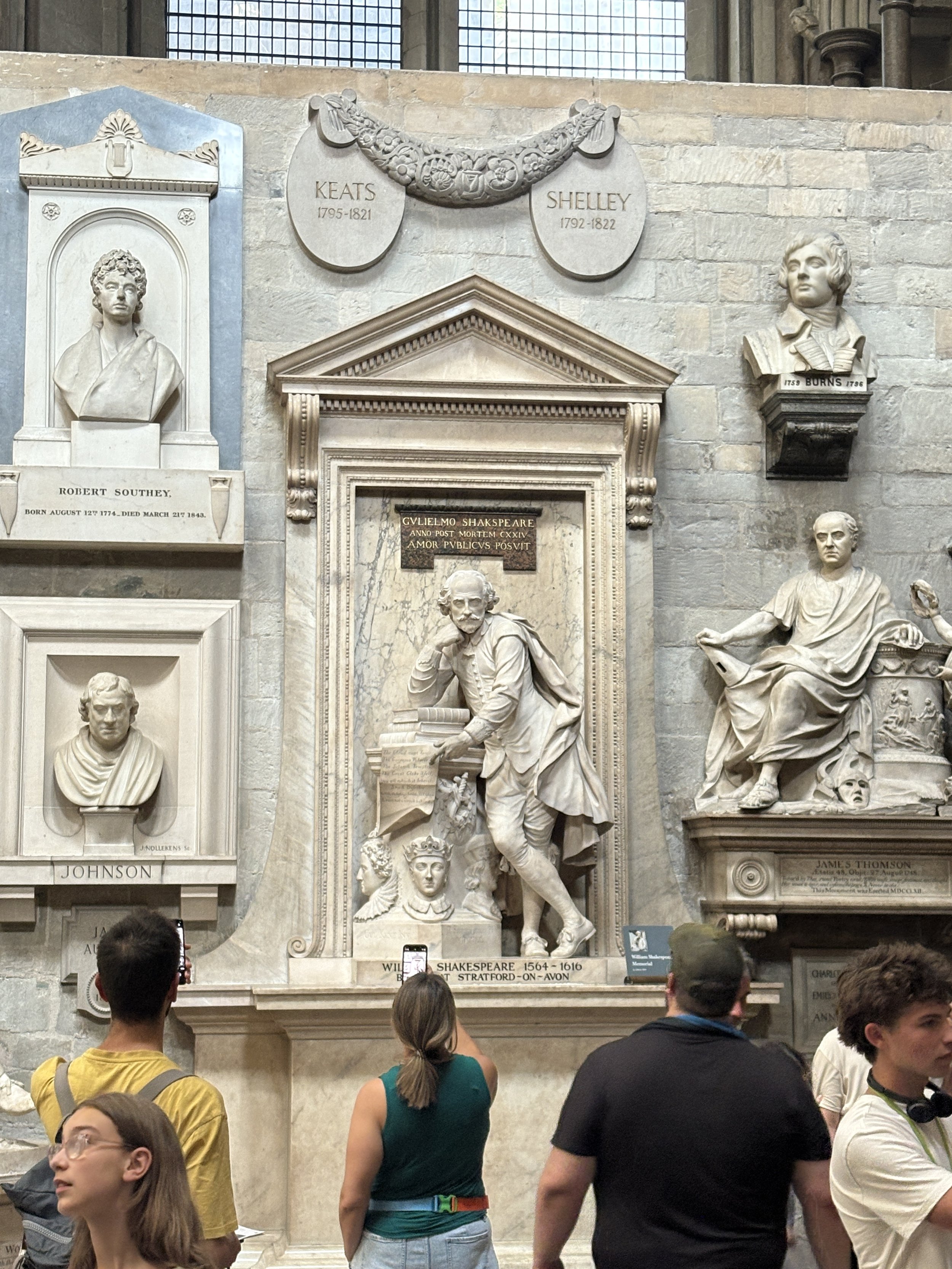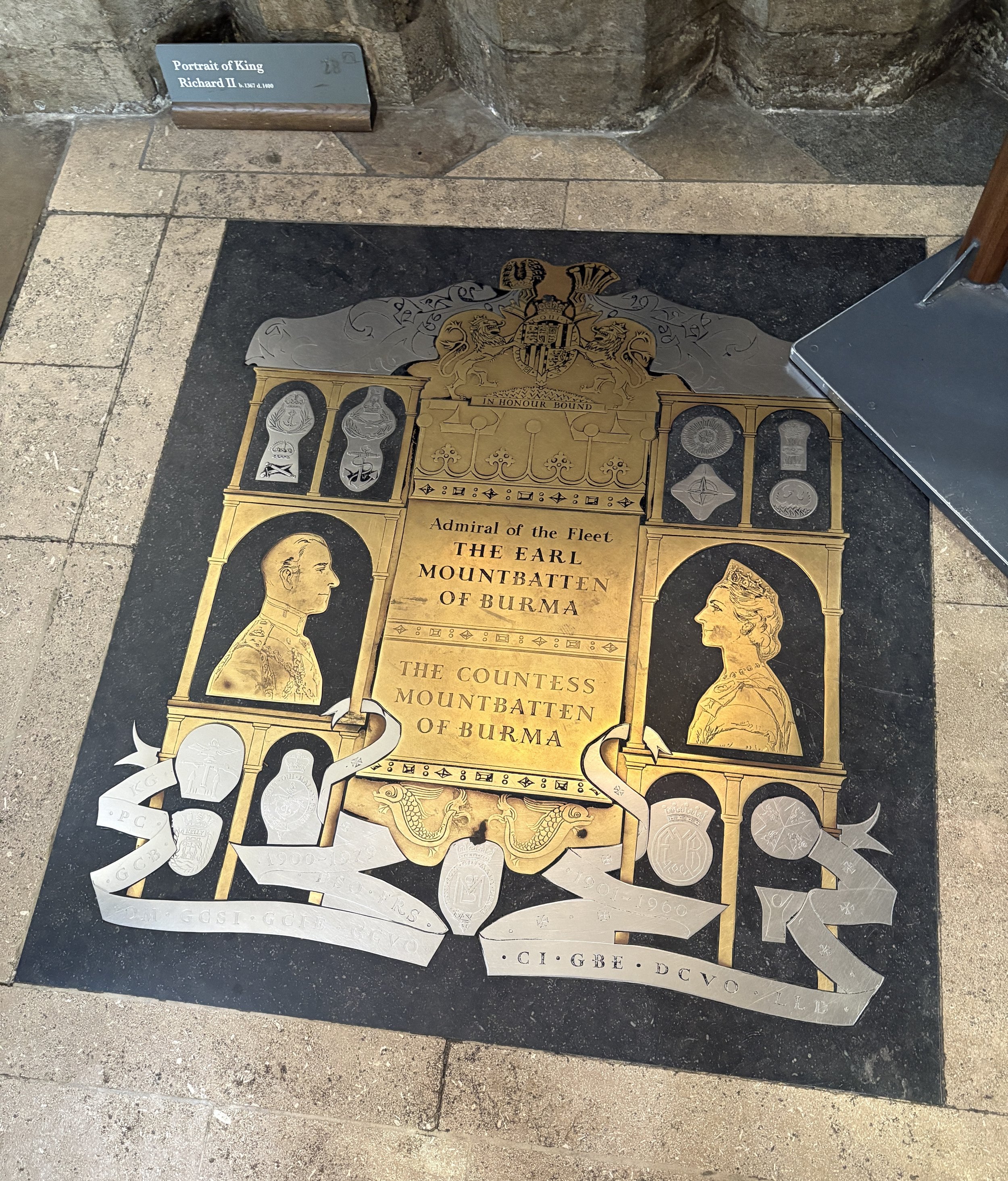1) Kensington High Street reminds me a little of Centre Street in JP, my own town center. Everything you need is there: a bank, a hardware store, a post office, a dry cleaner, a pharmacy, a convenience store, a stationer, a few restaurants, even a house museum*. I feel at home here.
2) It has been hot, and even though I woke early, I started the day late in the morning with errands. I had no plans, and I started to get that feeling that if I didn’t do something, I was going to fall into a Bad Mood. Solution: book an afternoon ticket to Westminster Abbey.
3) That meant noon lunch at a nearby Italian restaurant, and the Circle Line from Kensington High Street to Westminster. And taking it all at a stately pace because of the heat.
4) A lot of tourists were sitting around wherever they could find shade around the Abbey. One group appeared to be a gathering of old veterans or something, and I was reminded of some of my old reunion classes as ye Instytytte.
4a) The lines to get into the Abbey are nothing like those to get into Notre Dame. I sat on a bench under a tree near the first checkpoint, assessing crowd movement and interest, and decided to take a chance and try to get in 15 minutes before my time. My gamble paid off.
5) Tourists first walk outside the church to a large side entrance, the North Porch. After that, barriers loosely guide one through the North Transept, the North Aisle, down the center of the nave through the choir, through the Ambulatory (which includes Henry VII’s Chapel), out the Ambulatory into Poet’s Corner, down the South Aisle, and then out the Western Door. Looking at a floor plan, I now realize I missed the cloister, but there’s a reason for that . . .
Haphazard.
5a) Long story short, it’s beautiful. Full of memorials, reeking of history (and a couple particular tourists), it all feels timeless, thoughtful, but haphazard.
5b) And not quite as full of people as the Mona Lisa gallery was at the Louvre, but . . . but it could have been.
5c) If Fame is guaranteed by a memorial in the Abbey, I do feel that those with floor plaques got the short end of the stick. Some of them have been worn to illegibility by centuries of feet, while others are obscured with racks of folding chairs or corners of signs.
5d) All these incredible monuments in the North Transept, triumphs of the sculptor’s art, and I found myself asking “Who on earth are these people?” At least I recognized the names of 19th-century prime ministers, whose statues were clustered together: Canning, Disraeli, Gladstone, Peel.
Brigadier General Hope’s memorial.
5e) How’s this for an epitaph? From the monument of Brigadier General Hope, “erected by his diƒconsolate widow,” who was so disconsolate she forgot to include his first name:
“To thoƒe who knew him
His name alone conveys the idea
Of all that is amiable in the human character:
Diƒtinguiƒhed by ƒplendor of family,
A cultivated taƒte for letters
And ƒuperior elegance of manners . . .”
5f) Another delightful innovation was the monument to Dr. John Blow, “Doctor of Musick” long associated with the Chapel Royal. His epitaph concluded “His own Muƒical Compoƒitions, (Eƒpecially his Church Muƒick) are a far nobler Monument to his Memory than any other can be raiƒ’d for Him.” And to illustrate it, the bottom of his monument is two pages of music, “A Canon of 4 Parts.”
5g) To walk from the nave into the choir was a beautiful experience, a realization that yes, I’m really here in this place. Its red lampshades and blue walls made it feel quite protected from the rest of the Abbey. And yet I was far from alone.
5h) Moving through the Ambulatory things started to feel more crowded and more medieval. The little chapels had only one entrance, and once I did have to mutter “There’s more room for you in there when we get out” at some impatient tourists. It’s just like riding the T . . .
Braids to the wind!
5i) But then I found the tombs of Elizabeth I and her sister, “Bloody Mary,” which was one of the most important reasons I was there in the first place. I don’t know why I thought Bess had been buried with her cousin and rival Mary, Queen of Scots (more on her in a moment), but in fact she shares a tomb with her half sister and rival Mary I. While their tombs are beautifully realized, what moved me most was the floor plaque at the entrance: “Near the tomb of Mary and Elizabeth, remember before God all those who divided at the Reformation by difference convictions laid down their lives for Christ and conscience sake.”
5j) Then came the Henry VII Chapel proper (Bess and Mary are buried in the side chapel on the left), which includes some pretty spectacular modern stained glass.
Mary!
5k) And at last, my beloved Mary, Queen of Scots, whose tomb is in the small chapel to the right. (And who, I gather, was brought there by her son, James VI and I, which I read about only last month in Queen James). Mary has been special to me ever since Mother and Daddy got us the World Book Encyclopedia in third grade. I was thrilled to discover her surviving embroidery at the V&A in 2019 (and again this year), and now here I was at her final resting place.
5l) Conservators were working on the tombs of Edward III and Richard II and there was a dear little sign explaining what they were doing that concluded “Please do not disturb, thank you.”
The head of the man at left obscures the small memorial to Jane Austen.
5m) Then I happened into the famous Poets Corner. Fancy America making such a memorial space available in the National Cathedral! (Perhaps they do?) In the Current Moment they’d probably be chiseling out particular writers. But here I recognized many names (not that I’ve read them all). I was specially delighted to see the master of the limerick, Edward Lear, memorialized.
5m.i) But most special was C.S. Lewis. My loving cousin Susan (may she rest in peace) gave us The Chronicles of Narnia when I was in junior high school, and later Daddy and I read some of his other books, including Surprised by Joy, The Four Loves, and The Great Divorce.
5n) At this point I had a moment of confusion, but then realized that access to the Queen’s Jubilee Galleries (for which I had a separate ticket), was through Poets Corner. And up a looooong and winding staircase, I staggered into the triforium, which is “an interior gallery, opening onto the tall central space of a building at an upper level,” that has been converted into a small museum of different aspects of the Abbey’s history. No photographs were permitted, alas — I caught myself almost taking a picture once, but I recollected myself — but what I remember most are the funeral effigies of the Stuart monarchs (who even knew they were a thing?!), Mary II’s coronation chair, Margaret Beaufort’s book of hours, and other amazing illuminated manuscripts. And the humidity. The triforium was open to the Abbey below, and I could feel my acrophobia kicking in. I was happy to take the elevator back down.
5o) Back in Poets Corner, I noticed a memorial figure with a particularly flamboyant pose parting two curtains. And I thought, “Mmmmm, gurrrrlllll . . . take your bow.” Turns out it was the great actor David Garrick, and that’s exactly what he was doing.
5p) I was sort of unclear where to go next, and then spotted behind a barrier the memorial plaque (in the floor) to Noel Coward, with an epitaph from his own work: “A talent to amuse.” I was trying to photograph it from behind the barrier when someone in priestly robes (a verger?) with a woman and child passed through the barrier. He turned to me and asked “Would you like to come through?” “May I please?!” “You’ll have to let yourself out,” he replied with a smile. And that’s how I got a closer look at Coward, Dame Sybil Thorndike, and John and Charles Wesley.
The murder of Thomas Thynn(e) in Pall Mall.
5p.i) One my way down the South Aisle, I passed that verger type man showing his companions the tomb of someone I’d never heard of, Thomas Thynn(e), whose murder in a coach on Pall Mall is illustrated on his memorial. It looked almost like a scene at the start of Forever Amber!
5q) Not too far away was the tomb of Major John André, the British officer conspiring with Benedict Arnold. He was captured by the Continental Army and executed. I remembered reading about this in elementary school.
But notice how their floor memorial is obscured by the base of a sign. Oopsie.
5r) Before leaving, I paid special attention to the Tomb of the Unknown Warrior, bordered with red poppies, where Queen Elizabeth the Queen Mother left her wedding bouquet in tribute (thus endearing herself to an entire nation). And also to the wall memorial to Franklin D. Roosevelt, “A Faithful Friend of Freedom.” And Gasped with Recognition at the beautiful floor brass of the Earl and Countess Mountbatten of Burma; I read her biography in Malta in ’22. And took note of William Congreve.
6) So . . . that was wonderful, and exhausting! And it was still so very hot outside. I had no imagination for anything else, and returned to my room via the Underground for a solid NAP.
7) Dragging myself out of bed at 6, I put myself together enough to go down to the street to an Italian restaurant for a negroni or two, insalata caprese, and some sort of chicken dish with potatoes. The Somewhat Flirty Waiter comped me a limoncello to conclude my evening.
*That would be the Loring-Greenough House.
















